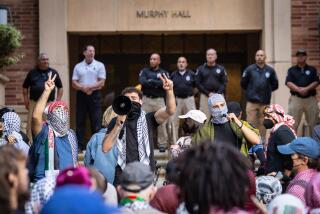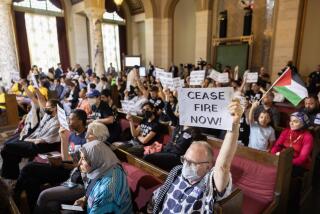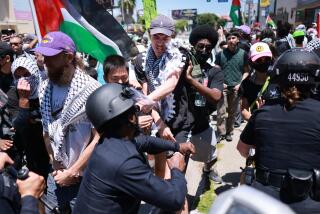Developing the Etiquette of Protest
The war started just as Police Chief Daryl F. Gates’s press conference was about to begin.
So, like millions of others, he dropped what he was doing and watched television. The reporters did, too, dashing over to a set in the department press relations office in Parker Center. Twenty-five minutes passed before everyone finally got together for the previously scheduled briefing on how the Police Department planned to control anti-war demonstrators and chase terrorists.
It’s always difficult to anticipate what version of the mercurial Gates you’ll get on a given day--outraged, calm, sarcastic, pleasant. But Wednesday’s Gates was a real surprise, given the gravity of the occasion and the growing schedule of anti-war rallies.
“We encourage demonstrators if they want to do it,” he said when the reporters asked him about the possibility of protests. “We’re hoping they do it in a peaceful way.”
Gates hasn’t been known as a friend of political protesters. I’ve seen him heap scorn on people who have made accusations of police brutality in demonstration control. But there was none of that at the press conference.
And, as Los Angeles’ first anti-war rally since fighting began unfolded at the Westwood Federal Building later in the evening, it looked as though Gates’ words had filtered down to the troops.
The scene had a ‘60s look. Performers sang the protest oldies. “Blowin’ in the Wind” resonated through the Santa Ana wind whipping around the corner of the Federal Building. Orators gave fiery speeches lumping the war together with poverty, capitalistic excess, sexism, racism and American imperialism in metaphors so mixed they sent your mind spinning.
Men, women and children and students from nearby UCLA and area high schools marched on the sidewalk in front of the Federal Building and crowded the broad lawn. About 50 performed for the television cameras live for the 6 o’clock news, standing and singing for an hour until they went on. “All we are saying is give peace a chance,” they sang, over and over.
They carried signs urging motorists to honk for peace. The motorists responded with a shrill symphony of auto horns, although, given the frantic impatience that characterizes driving on the Westside, it was hard to tell whether they were against the war or just angry at the slow-moving traffic.
But as the evening went on, you could see that this was no carbon copy of a ‘60s rally. Rather, the rally organizers had learned something from the almost decade of continuous protests against the Vietnam War and the many political protests that followed.
Among them were veterans of protests against American involvement in Nicaragua and El Salvador, two causes that brought the cops and demonstrators together frequently. Others were from unions, including some wearing “Justice for Janitors” jackets, mementos of the campaign to organize low-paid office building custodians into unions. One of their marches led to a confrontation with police in Century City last June in which 40 protesters were arrested and about two dozen injured.
They drew on all this past experience. They policed themselves, for example. I saw that late in the evening when I was interviewing one of the demonstrators, Kyung Kyu Lim of the Young Koreans United For Los Angeles. A man walked over and said softly to Lim, “We need you, we have a potentially major security problem.” Lim left and began moving between bitterly arguing pro- and anti-war people, separating the angriest opponents.
The police learned, too.
Police Sgt. Dave Rossi said he’d been working with the organizers. Sounding like Chief Gates, Rossi said, “I was telling the organizers, demonstrate as long as they don’t break the law.”
Rossi had learned something even more specific at a demonstration at the Federal Building the night before.
He’d had officers block Wilshire Boulevard, preventing cars from passing the demonstration. The demonstrators, he said, had no audience. Frustrated, they sat down at the intersection of Wilshire and Veteran Avenue. Others marched into Westwood Village. Several were arrested.
Monday night, Rossi changed tactics. He permitted cars to pass along Wilshire Boulevard. Everyone, he said, kept cool.
At Parker Center Tuesday morning, some of the police talked about the lessons of the night before.
It doesn’t mean, they agreed, that the anti-war demonstrators and the cops are going to be best friends. What happened Wednesday night is that both sides conducted themselves with civility, and that’s a hopeful sign for the difficult months ahead.
More to Read
Get the L.A. Times Politics newsletter
Deeply reported insights into legislation, politics and policy from Sacramento, Washington and beyond. In your inbox three times per week.
You may occasionally receive promotional content from the Los Angeles Times.










